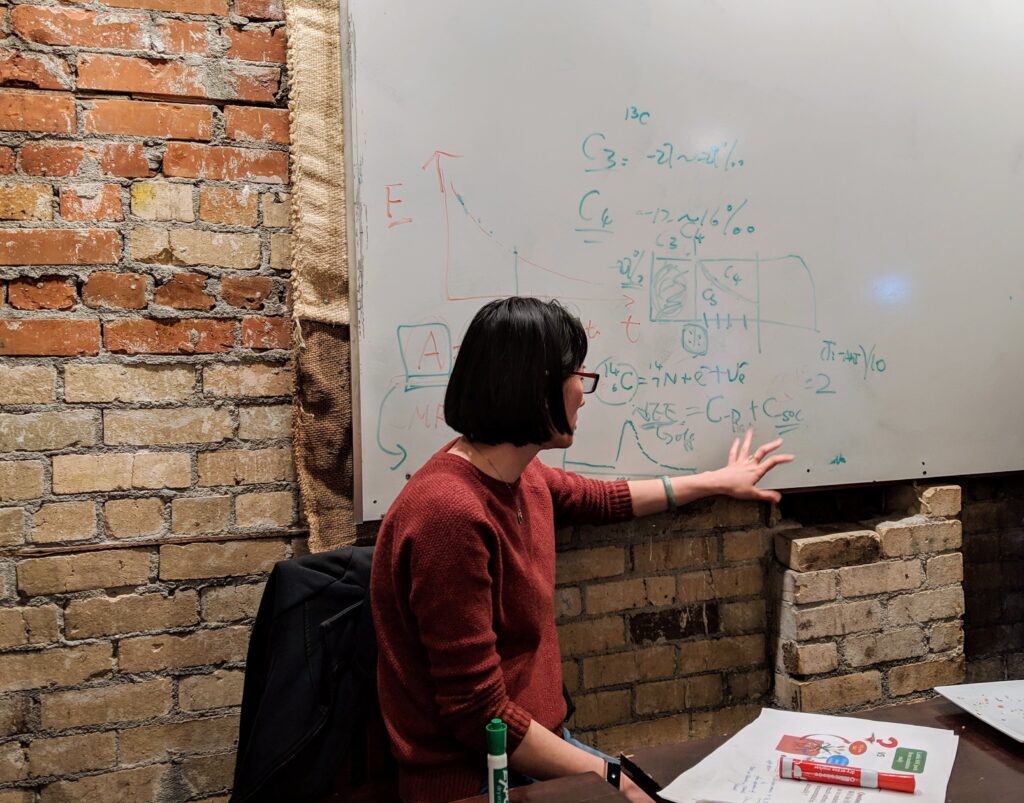
During CAF LTAR’s DataCAFe, Qiuping (Ellen) Peng led a discussion on different methods of calculating mean residence time (MRT) of soil organic matter. After much discussion and merriment, Ellen then tried to steer the crowd towards a discussion on how to relate MRT to flux data from EC towers. Her write up is below.
Understanding the turnover rate of soil organic carbon (SOC) is essential to accurately estimate carbon budget and predict ecosystem response to future global climate change (Scharlemann et al., 2014; Schmidt et al., 2011). More importantly, through the turnover rates of SOC, we can better understand SOC residence time and identify what practices are effective in sequestrating SOC that persists longer in an ecosystem (Schmidt et al., 2011). Simultaneously, it can be helpful for land managers to assess their soil quality and adapt their management in an early stage before soil degradation happens (Awale et al., 2017).

There are four different approaches to obtain SOC turnover rates at various timescales and spatial scales, includes natural radioactive 14C dating (Hsieh, 1993; Paul et al., 1997; Paul et al., 2001; Trumbore et al., 1989; Trumbore, 2000; Trumbore, 2006) , stable isotope 13C tracing (Acton et al., 2013; Cheng et al., 2007; Crow et al., 2006; De Clercq et al., 2015; Gregorich et al., 1995; Huggins et al., 1998; Liao et al., 2006), laboratory incubation study (Collins et al., 2000; Paul et al., 2006; Rabbi et al., 2014; Keidel et al., 2018; Crow and Sierra, 2018; Zachary et al., 2018) and field observation with modeling (Carvalhais et al., 2014; Chen et al., 2013; Garten Jr and Hanson, 2006), as illustrated in Figure 1. The first three methods obey the same rule of first order decay model with the assumption of a steady-state system (the input flow is equal to the output flow). Under that assumption, the reciprocal of turnover rate is calculated as the mean residence time (MRT) (Bolin and Rodhe, 1973). In the field observation method, with CO2 flux measurement and the steady-state assumption, MRT can be computed by the efflux divided by the total SOC stock at certain depth, usually the top 30 cm are common (Carvalhais et al., 2014; Chen et al., 2013). Using 14C dating techniques and mass balance method, we are able to detect the apparent mean age of C atoms that have existed in the system for thousands of years (Paul et al., 2001). With 13C abundance change caused by the switch of C3 and C4 plants, we can get the turnover rates of a mixed pool, which is labile in a time scale of decades (Gregorich et al., 1995; Huggins et al., 1998). Likewise, the laboratory incubation study is capable of capturing the carbon that can be depleted within days and years (Collins et al., 2000; Crow and Sierra, 2018; Zachary et al., 2018). The field observation with modeling method estimates the MRT of SOC pools at the similar magnitude of decades as 13C stable natural abundance method (Carvalhais et al., 2014; Chen et al., 2013).
It is worthwhile to note that the turnover rates of SOC calculated from these four methods are actually targeting different pools at various stages due to decomposition process related to variable climate and vegetation types, which lead to challenges of SOC pool comparison across samples, regions and methods. Furthermore, MRT reported in a larger timescale become less meaningful in providing instant and informative assessment for land managers in a short timescale. More importantly, the fast-cycling SOC pools, which determines the soil as a carbon sink or source and system sustainability, is more sensitive to changes in the environmental factors and land management (Crow and Sierra, 2018). Therefore, we ask the following questions:
- Can the fast-cycling pool be broken into some subunits performing similar functions through a long-term incubation study?
- If so, are those characterized as labile pool subunits relatable with chemical fractioned pools, which had been recognized to be more sensitive to land management in a relative short timescale?
- Is there a way of combining lab study with field observation to understand how crop types contribute to SOC fast-cycling pool dynamics?
